Analyzing Leadership and Management in Starbucks Operations
VerifiedAdded on 2023/06/18
|9
|2135
|225
Report
AI Summary
This report provides an analysis of management and leadership roles within Starbucks Corporation, differentiating between the functions of managers and leaders and examining how these roles apply in various situational contexts such as slow, stable, and fast-paced environments. It explores the application of different leadership theories and models, including situational, systems, and contingency leadership, to enhance organizational productivity. The report concludes that both managers and leaders play essential roles in achieving company objectives, adapting their leadership styles to meet the demands of different situations and emphasizing the importance of motivating and guiding employees to ensure overall success. Desklib offers a wealth of similar solved assignments and study resources for students.
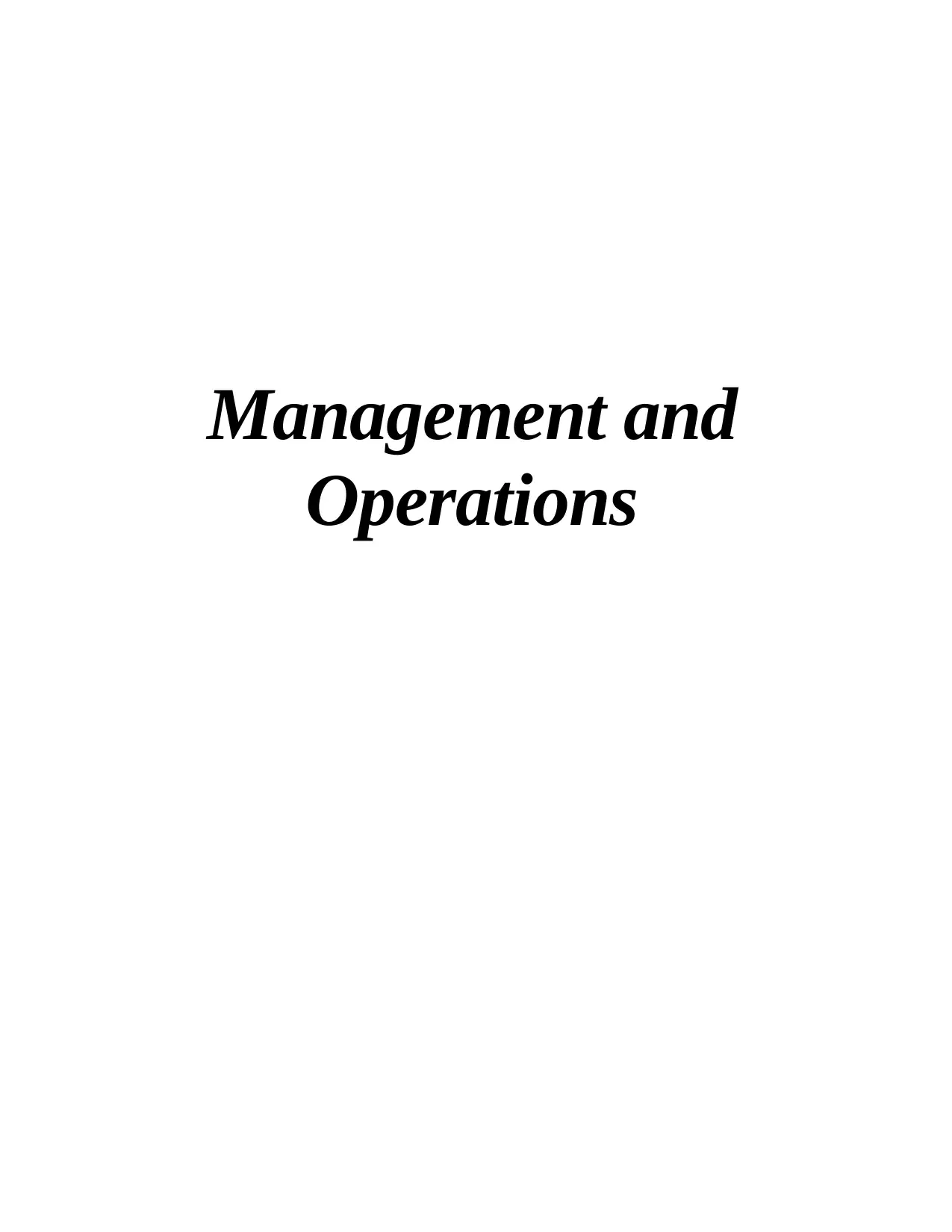
Management and
Operations
Operations
Paraphrase This Document
Need a fresh take? Get an instant paraphrase of this document with our AI Paraphraser
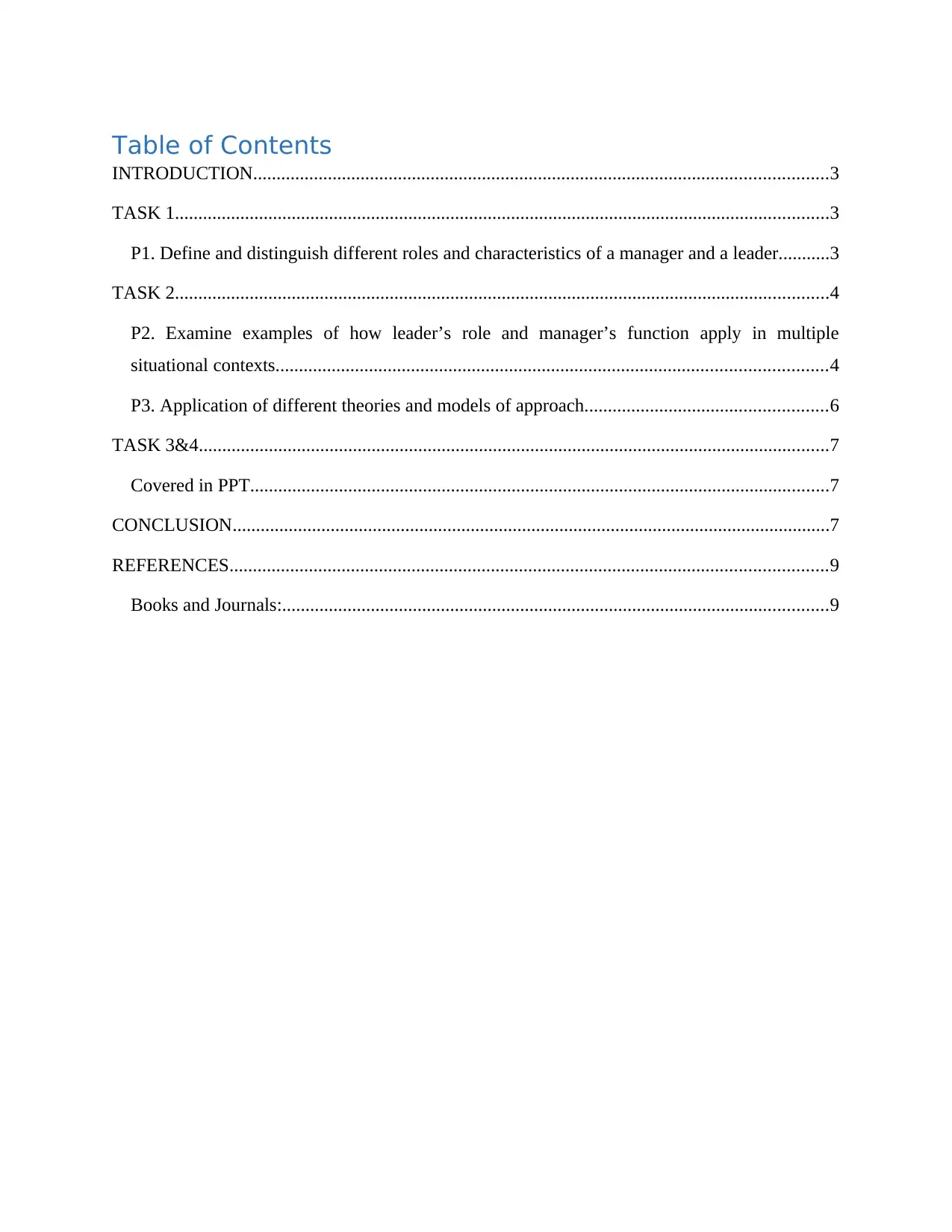
Table of Contents
INTRODUCTION...........................................................................................................................3
TASK 1............................................................................................................................................3
P1. Define and distinguish different roles and characteristics of a manager and a leader...........3
TASK 2............................................................................................................................................4
P2. Examine examples of how leader’s role and manager’s function apply in multiple
situational contexts......................................................................................................................4
P3. Application of different theories and models of approach....................................................6
TASK 3&4.......................................................................................................................................7
Covered in PPT............................................................................................................................7
CONCLUSION................................................................................................................................7
REFERENCES................................................................................................................................9
Books and Journals:.....................................................................................................................9
INTRODUCTION...........................................................................................................................3
TASK 1............................................................................................................................................3
P1. Define and distinguish different roles and characteristics of a manager and a leader...........3
TASK 2............................................................................................................................................4
P2. Examine examples of how leader’s role and manager’s function apply in multiple
situational contexts......................................................................................................................4
P3. Application of different theories and models of approach....................................................6
TASK 3&4.......................................................................................................................................7
Covered in PPT............................................................................................................................7
CONCLUSION................................................................................................................................7
REFERENCES................................................................................................................................9
Books and Journals:.....................................................................................................................9
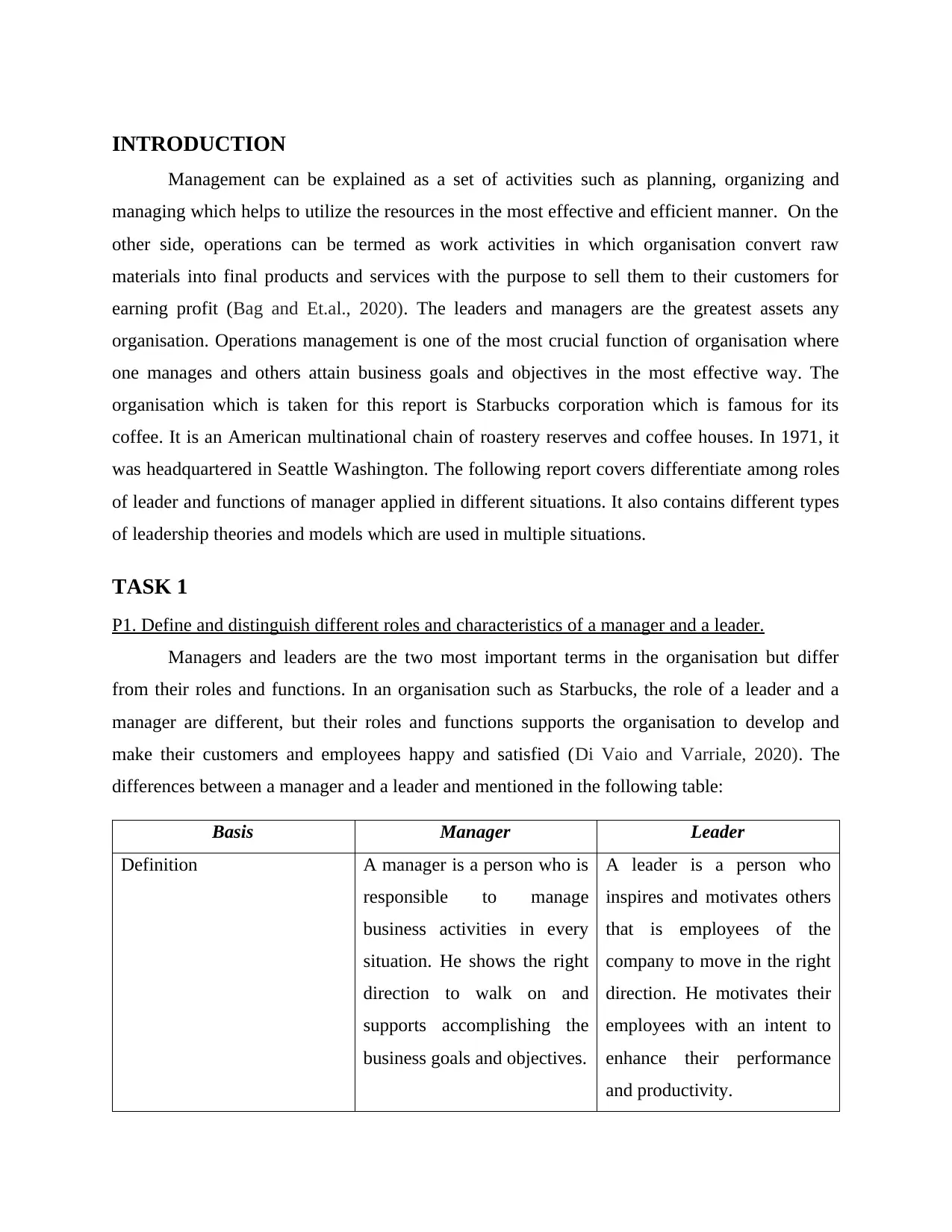
INTRODUCTION
Management can be explained as a set of activities such as planning, organizing and
managing which helps to utilize the resources in the most effective and efficient manner. On the
other side, operations can be termed as work activities in which organisation convert raw
materials into final products and services with the purpose to sell them to their customers for
earning profit (Bag and Et.al., 2020). The leaders and managers are the greatest assets any
organisation. Operations management is one of the most crucial function of organisation where
one manages and others attain business goals and objectives in the most effective way. The
organisation which is taken for this report is Starbucks corporation which is famous for its
coffee. It is an American multinational chain of roastery reserves and coffee houses. In 1971, it
was headquartered in Seattle Washington. The following report covers differentiate among roles
of leader and functions of manager applied in different situations. It also contains different types
of leadership theories and models which are used in multiple situations.
TASK 1
P1. Define and distinguish different roles and characteristics of a manager and a leader.
Managers and leaders are the two most important terms in the organisation but differ
from their roles and functions. In an organisation such as Starbucks, the role of a leader and a
manager are different, but their roles and functions supports the organisation to develop and
make their customers and employees happy and satisfied (Di Vaio and Varriale, 2020). The
differences between a manager and a leader and mentioned in the following table:
Basis Manager Leader
Definition A manager is a person who is
responsible to manage
business activities in every
situation. He shows the right
direction to walk on and
supports accomplishing the
business goals and objectives.
A leader is a person who
inspires and motivates others
that is employees of the
company to move in the right
direction. He motivates their
employees with an intent to
enhance their performance
and productivity.
Management can be explained as a set of activities such as planning, organizing and
managing which helps to utilize the resources in the most effective and efficient manner. On the
other side, operations can be termed as work activities in which organisation convert raw
materials into final products and services with the purpose to sell them to their customers for
earning profit (Bag and Et.al., 2020). The leaders and managers are the greatest assets any
organisation. Operations management is one of the most crucial function of organisation where
one manages and others attain business goals and objectives in the most effective way. The
organisation which is taken for this report is Starbucks corporation which is famous for its
coffee. It is an American multinational chain of roastery reserves and coffee houses. In 1971, it
was headquartered in Seattle Washington. The following report covers differentiate among roles
of leader and functions of manager applied in different situations. It also contains different types
of leadership theories and models which are used in multiple situations.
TASK 1
P1. Define and distinguish different roles and characteristics of a manager and a leader.
Managers and leaders are the two most important terms in the organisation but differ
from their roles and functions. In an organisation such as Starbucks, the role of a leader and a
manager are different, but their roles and functions supports the organisation to develop and
make their customers and employees happy and satisfied (Di Vaio and Varriale, 2020). The
differences between a manager and a leader and mentioned in the following table:
Basis Manager Leader
Definition A manager is a person who is
responsible to manage
business activities in every
situation. He shows the right
direction to walk on and
supports accomplishing the
business goals and objectives.
A leader is a person who
inspires and motivates others
that is employees of the
company to move in the right
direction. He motivates their
employees with an intent to
enhance their performance
and productivity.
⊘ This is a preview!⊘
Do you want full access?
Subscribe today to unlock all pages.

Trusted by 1+ million students worldwide
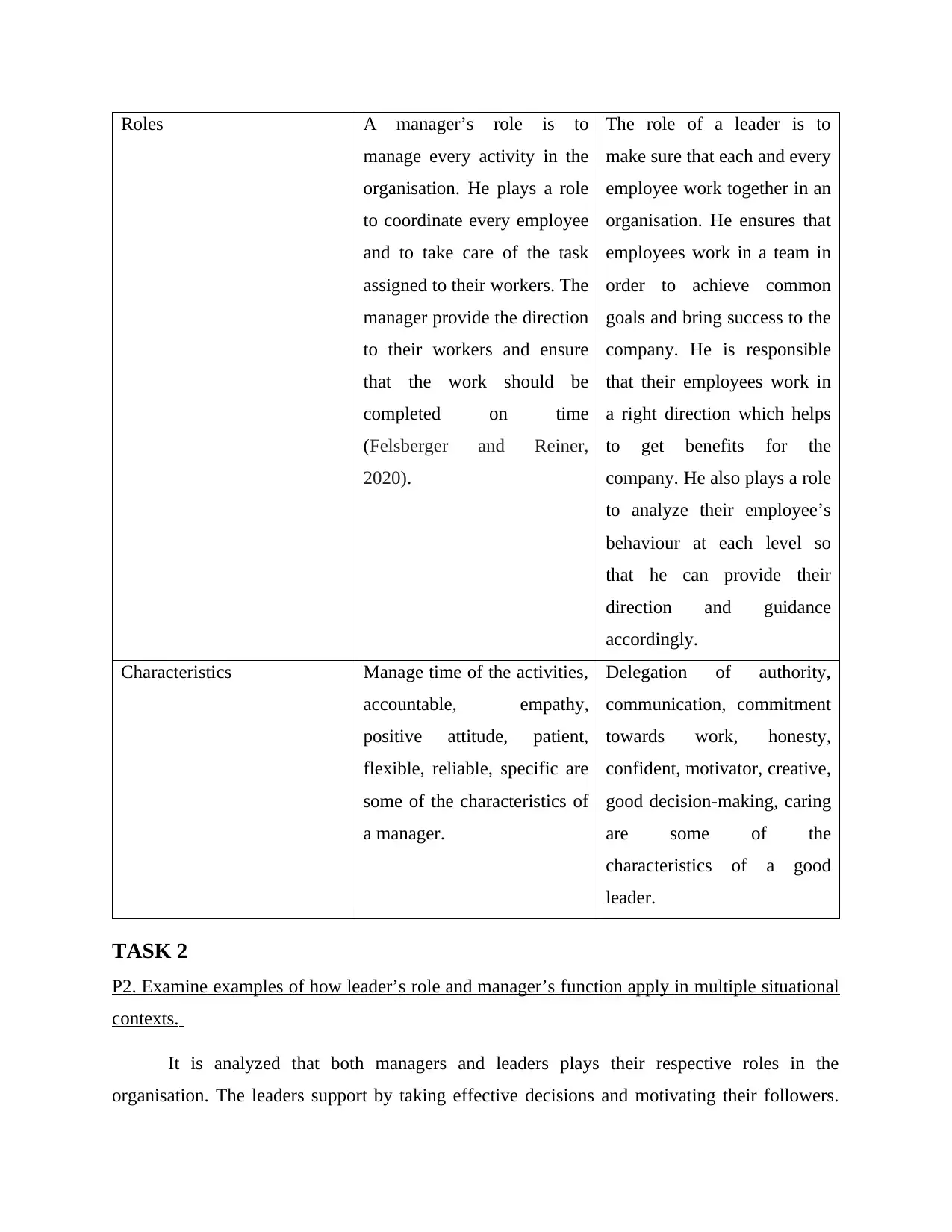
Roles A manager’s role is to
manage every activity in the
organisation. He plays a role
to coordinate every employee
and to take care of the task
assigned to their workers. The
manager provide the direction
to their workers and ensure
that the work should be
completed on time
(Felsberger and Reiner,
2020).
The role of a leader is to
make sure that each and every
employee work together in an
organisation. He ensures that
employees work in a team in
order to achieve common
goals and bring success to the
company. He is responsible
that their employees work in
a right direction which helps
to get benefits for the
company. He also plays a role
to analyze their employee’s
behaviour at each level so
that he can provide their
direction and guidance
accordingly.
Characteristics Manage time of the activities,
accountable, empathy,
positive attitude, patient,
flexible, reliable, specific are
some of the characteristics of
a manager.
Delegation of authority,
communication, commitment
towards work, honesty,
confident, motivator, creative,
good decision-making, caring
are some of the
characteristics of a good
leader.
TASK 2
P2. Examine examples of how leader’s role and manager’s function apply in multiple situational
contexts.
It is analyzed that both managers and leaders plays their respective roles in the
organisation. The leaders support by taking effective decisions and motivating their followers.
manage every activity in the
organisation. He plays a role
to coordinate every employee
and to take care of the task
assigned to their workers. The
manager provide the direction
to their workers and ensure
that the work should be
completed on time
(Felsberger and Reiner,
2020).
The role of a leader is to
make sure that each and every
employee work together in an
organisation. He ensures that
employees work in a team in
order to achieve common
goals and bring success to the
company. He is responsible
that their employees work in
a right direction which helps
to get benefits for the
company. He also plays a role
to analyze their employee’s
behaviour at each level so
that he can provide their
direction and guidance
accordingly.
Characteristics Manage time of the activities,
accountable, empathy,
positive attitude, patient,
flexible, reliable, specific are
some of the characteristics of
a manager.
Delegation of authority,
communication, commitment
towards work, honesty,
confident, motivator, creative,
good decision-making, caring
are some of the
characteristics of a good
leader.
TASK 2
P2. Examine examples of how leader’s role and manager’s function apply in multiple situational
contexts.
It is analyzed that both managers and leaders plays their respective roles in the
organisation. The leaders support by taking effective decisions and motivating their followers.
Paraphrase This Document
Need a fresh take? Get an instant paraphrase of this document with our AI Paraphraser
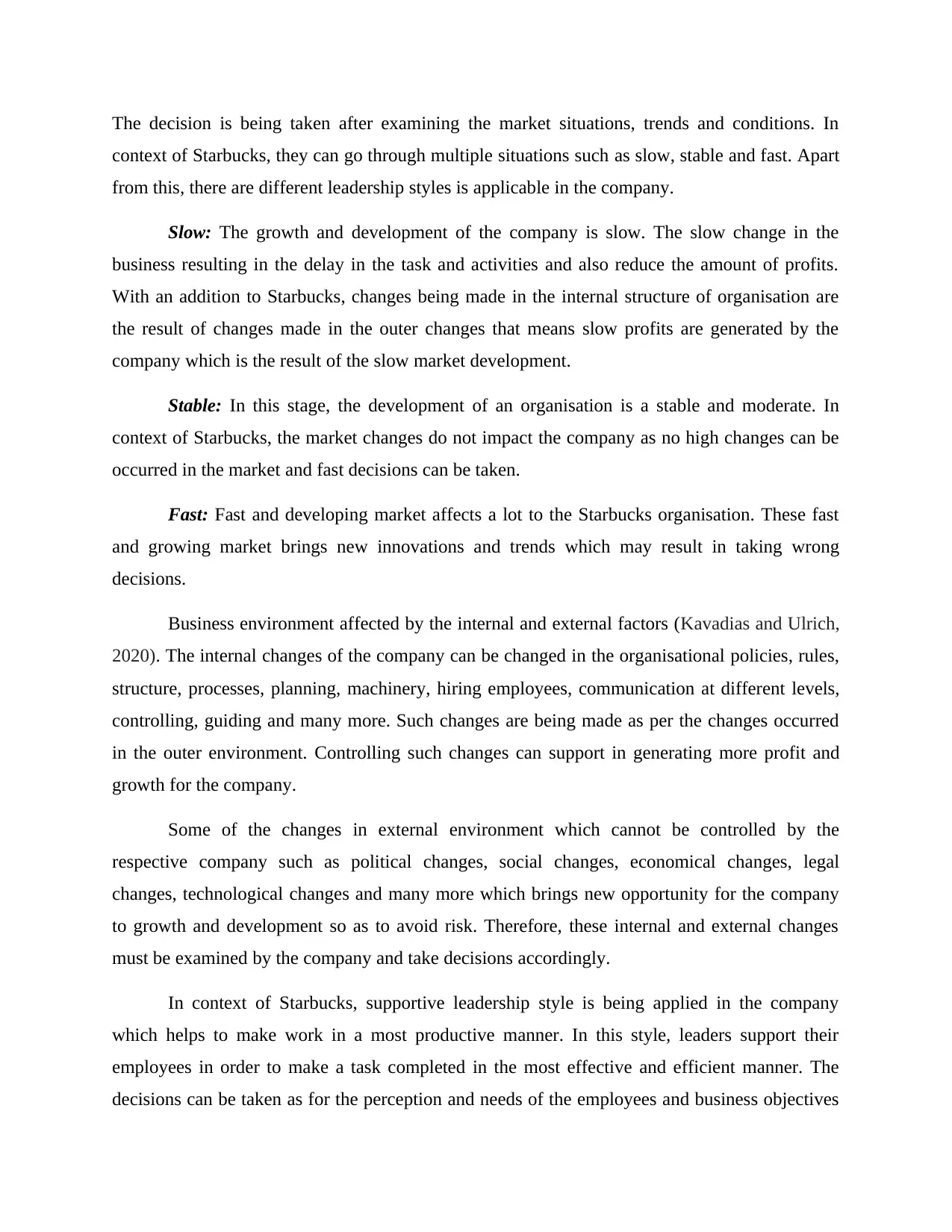
The decision is being taken after examining the market situations, trends and conditions. In
context of Starbucks, they can go through multiple situations such as slow, stable and fast. Apart
from this, there are different leadership styles is applicable in the company.
Slow: The growth and development of the company is slow. The slow change in the
business resulting in the delay in the task and activities and also reduce the amount of profits.
With an addition to Starbucks, changes being made in the internal structure of organisation are
the result of changes made in the outer changes that means slow profits are generated by the
company which is the result of the slow market development.
Stable: In this stage, the development of an organisation is a stable and moderate. In
context of Starbucks, the market changes do not impact the company as no high changes can be
occurred in the market and fast decisions can be taken.
Fast: Fast and developing market affects a lot to the Starbucks organisation. These fast
and growing market brings new innovations and trends which may result in taking wrong
decisions.
Business environment affected by the internal and external factors (Kavadias and Ulrich,
2020). The internal changes of the company can be changed in the organisational policies, rules,
structure, processes, planning, machinery, hiring employees, communication at different levels,
controlling, guiding and many more. Such changes are being made as per the changes occurred
in the outer environment. Controlling such changes can support in generating more profit and
growth for the company.
Some of the changes in external environment which cannot be controlled by the
respective company such as political changes, social changes, economical changes, legal
changes, technological changes and many more which brings new opportunity for the company
to growth and development so as to avoid risk. Therefore, these internal and external changes
must be examined by the company and take decisions accordingly.
In context of Starbucks, supportive leadership style is being applied in the company
which helps to make work in a most productive manner. In this style, leaders support their
employees in order to make a task completed in the most effective and efficient manner. The
decisions can be taken as for the perception and needs of the employees and business objectives
context of Starbucks, they can go through multiple situations such as slow, stable and fast. Apart
from this, there are different leadership styles is applicable in the company.
Slow: The growth and development of the company is slow. The slow change in the
business resulting in the delay in the task and activities and also reduce the amount of profits.
With an addition to Starbucks, changes being made in the internal structure of organisation are
the result of changes made in the outer changes that means slow profits are generated by the
company which is the result of the slow market development.
Stable: In this stage, the development of an organisation is a stable and moderate. In
context of Starbucks, the market changes do not impact the company as no high changes can be
occurred in the market and fast decisions can be taken.
Fast: Fast and developing market affects a lot to the Starbucks organisation. These fast
and growing market brings new innovations and trends which may result in taking wrong
decisions.
Business environment affected by the internal and external factors (Kavadias and Ulrich,
2020). The internal changes of the company can be changed in the organisational policies, rules,
structure, processes, planning, machinery, hiring employees, communication at different levels,
controlling, guiding and many more. Such changes are being made as per the changes occurred
in the outer environment. Controlling such changes can support in generating more profit and
growth for the company.
Some of the changes in external environment which cannot be controlled by the
respective company such as political changes, social changes, economical changes, legal
changes, technological changes and many more which brings new opportunity for the company
to growth and development so as to avoid risk. Therefore, these internal and external changes
must be examined by the company and take decisions accordingly.
In context of Starbucks, supportive leadership style is being applied in the company
which helps to make work in a most productive manner. In this style, leaders support their
employees in order to make a task completed in the most effective and efficient manner. The
decisions can be taken as for the perception and needs of the employees and business objectives
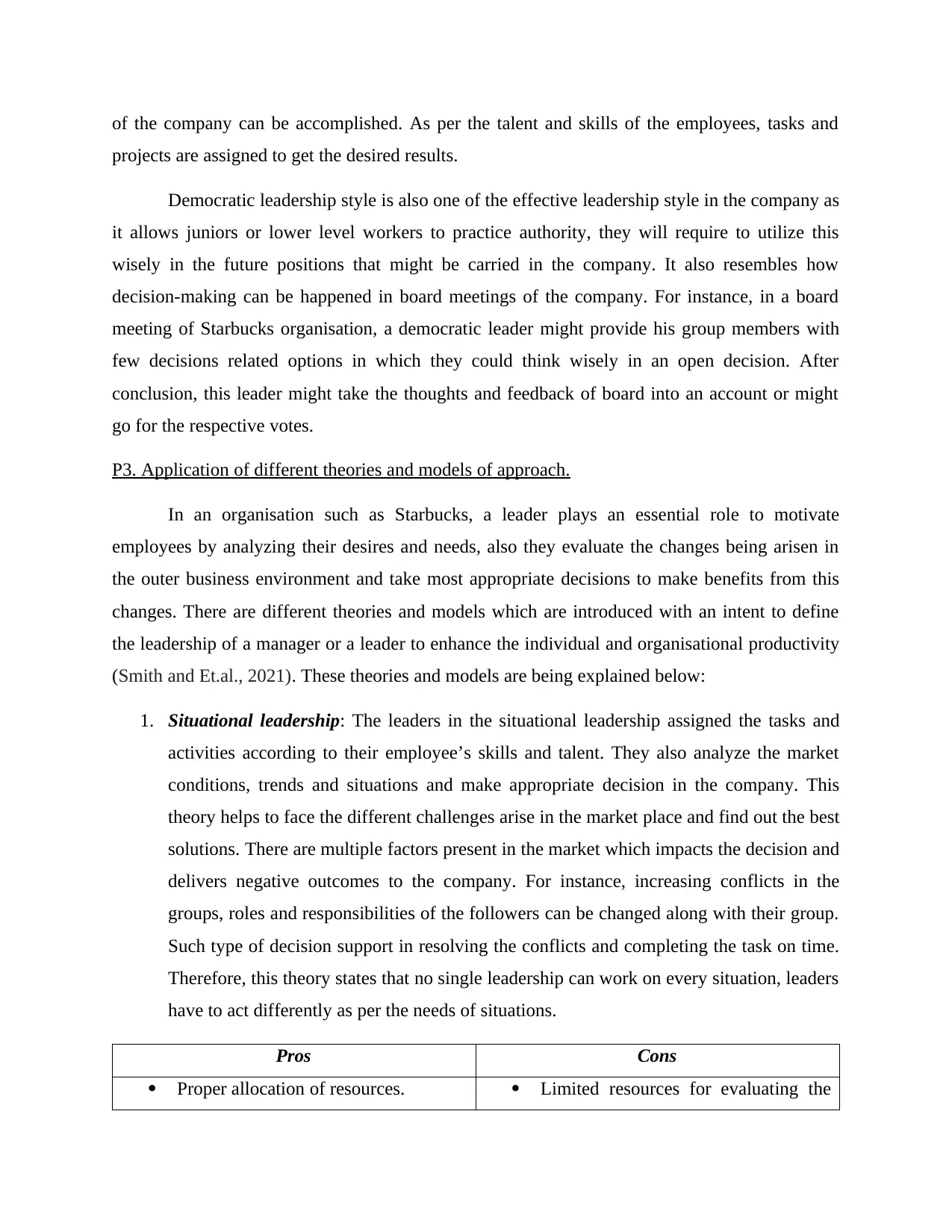
of the company can be accomplished. As per the talent and skills of the employees, tasks and
projects are assigned to get the desired results.
Democratic leadership style is also one of the effective leadership style in the company as
it allows juniors or lower level workers to practice authority, they will require to utilize this
wisely in the future positions that might be carried in the company. It also resembles how
decision-making can be happened in board meetings of the company. For instance, in a board
meeting of Starbucks organisation, a democratic leader might provide his group members with
few decisions related options in which they could think wisely in an open decision. After
conclusion, this leader might take the thoughts and feedback of board into an account or might
go for the respective votes.
P3. Application of different theories and models of approach.
In an organisation such as Starbucks, a leader plays an essential role to motivate
employees by analyzing their desires and needs, also they evaluate the changes being arisen in
the outer business environment and take most appropriate decisions to make benefits from this
changes. There are different theories and models which are introduced with an intent to define
the leadership of a manager or a leader to enhance the individual and organisational productivity
(Smith and Et.al., 2021). These theories and models are being explained below:
1. Situational leadership: The leaders in the situational leadership assigned the tasks and
activities according to their employee’s skills and talent. They also analyze the market
conditions, trends and situations and make appropriate decision in the company. This
theory helps to face the different challenges arise in the market place and find out the best
solutions. There are multiple factors present in the market which impacts the decision and
delivers negative outcomes to the company. For instance, increasing conflicts in the
groups, roles and responsibilities of the followers can be changed along with their group.
Such type of decision support in resolving the conflicts and completing the task on time.
Therefore, this theory states that no single leadership can work on every situation, leaders
have to act differently as per the needs of situations.
Pros Cons
Proper allocation of resources. Limited resources for evaluating the
projects are assigned to get the desired results.
Democratic leadership style is also one of the effective leadership style in the company as
it allows juniors or lower level workers to practice authority, they will require to utilize this
wisely in the future positions that might be carried in the company. It also resembles how
decision-making can be happened in board meetings of the company. For instance, in a board
meeting of Starbucks organisation, a democratic leader might provide his group members with
few decisions related options in which they could think wisely in an open decision. After
conclusion, this leader might take the thoughts and feedback of board into an account or might
go for the respective votes.
P3. Application of different theories and models of approach.
In an organisation such as Starbucks, a leader plays an essential role to motivate
employees by analyzing their desires and needs, also they evaluate the changes being arisen in
the outer business environment and take most appropriate decisions to make benefits from this
changes. There are different theories and models which are introduced with an intent to define
the leadership of a manager or a leader to enhance the individual and organisational productivity
(Smith and Et.al., 2021). These theories and models are being explained below:
1. Situational leadership: The leaders in the situational leadership assigned the tasks and
activities according to their employee’s skills and talent. They also analyze the market
conditions, trends and situations and make appropriate decision in the company. This
theory helps to face the different challenges arise in the market place and find out the best
solutions. There are multiple factors present in the market which impacts the decision and
delivers negative outcomes to the company. For instance, increasing conflicts in the
groups, roles and responsibilities of the followers can be changed along with their group.
Such type of decision support in resolving the conflicts and completing the task on time.
Therefore, this theory states that no single leadership can work on every situation, leaders
have to act differently as per the needs of situations.
Pros Cons
Proper allocation of resources. Limited resources for evaluating the
⊘ This is a preview!⊘
Do you want full access?
Subscribe today to unlock all pages.

Trusted by 1+ million students worldwide
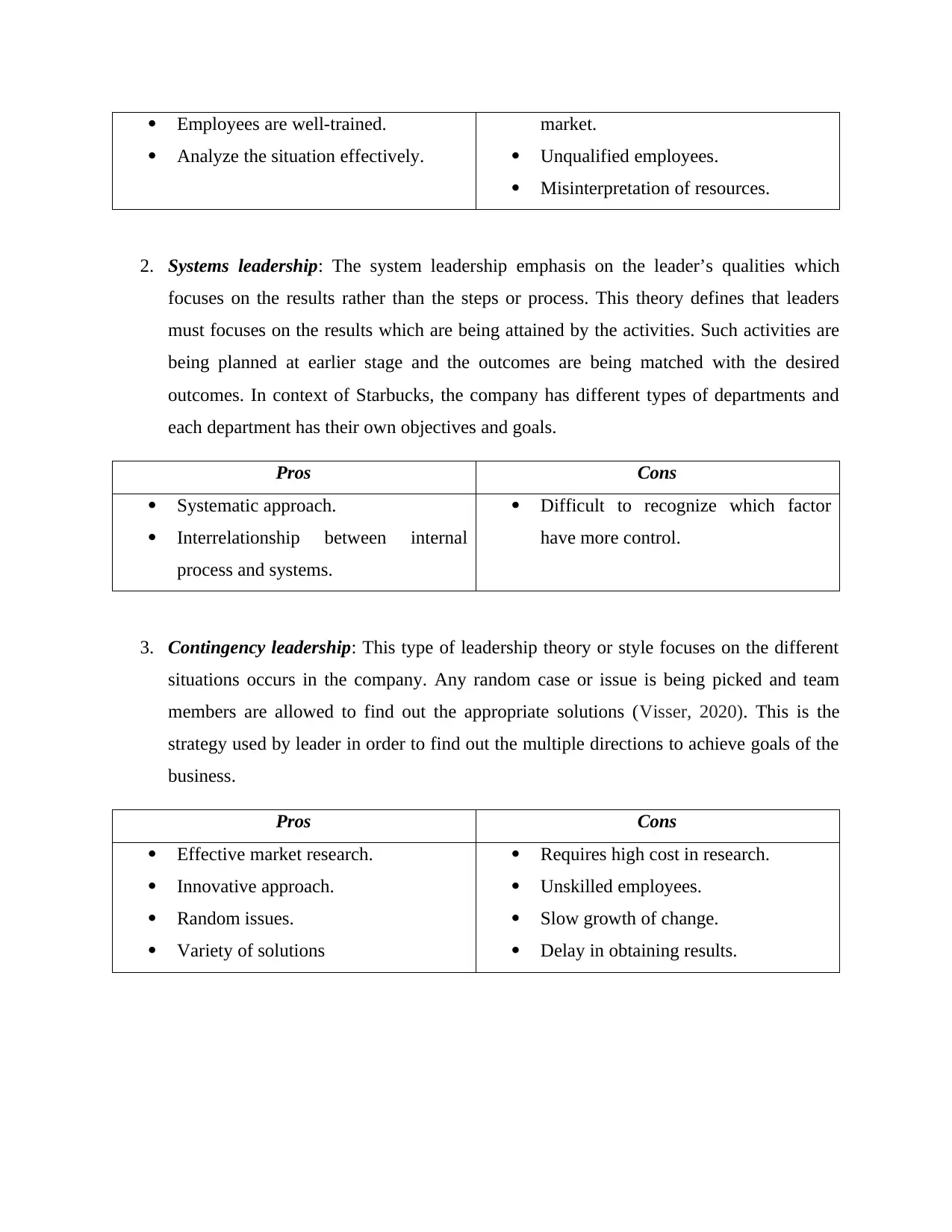
Employees are well-trained.
Analyze the situation effectively.
market.
Unqualified employees.
Misinterpretation of resources.
2. Systems leadership: The system leadership emphasis on the leader’s qualities which
focuses on the results rather than the steps or process. This theory defines that leaders
must focuses on the results which are being attained by the activities. Such activities are
being planned at earlier stage and the outcomes are being matched with the desired
outcomes. In context of Starbucks, the company has different types of departments and
each department has their own objectives and goals.
Pros Cons
Systematic approach.
Interrelationship between internal
process and systems.
Difficult to recognize which factor
have more control.
3. Contingency leadership: This type of leadership theory or style focuses on the different
situations occurs in the company. Any random case or issue is being picked and team
members are allowed to find out the appropriate solutions (Visser, 2020). This is the
strategy used by leader in order to find out the multiple directions to achieve goals of the
business.
Pros Cons
Effective market research.
Innovative approach.
Random issues.
Variety of solutions
Requires high cost in research.
Unskilled employees.
Slow growth of change.
Delay in obtaining results.
Analyze the situation effectively.
market.
Unqualified employees.
Misinterpretation of resources.
2. Systems leadership: The system leadership emphasis on the leader’s qualities which
focuses on the results rather than the steps or process. This theory defines that leaders
must focuses on the results which are being attained by the activities. Such activities are
being planned at earlier stage and the outcomes are being matched with the desired
outcomes. In context of Starbucks, the company has different types of departments and
each department has their own objectives and goals.
Pros Cons
Systematic approach.
Interrelationship between internal
process and systems.
Difficult to recognize which factor
have more control.
3. Contingency leadership: This type of leadership theory or style focuses on the different
situations occurs in the company. Any random case or issue is being picked and team
members are allowed to find out the appropriate solutions (Visser, 2020). This is the
strategy used by leader in order to find out the multiple directions to achieve goals of the
business.
Pros Cons
Effective market research.
Innovative approach.
Random issues.
Variety of solutions
Requires high cost in research.
Unskilled employees.
Slow growth of change.
Delay in obtaining results.
Paraphrase This Document
Need a fresh take? Get an instant paraphrase of this document with our AI Paraphraser
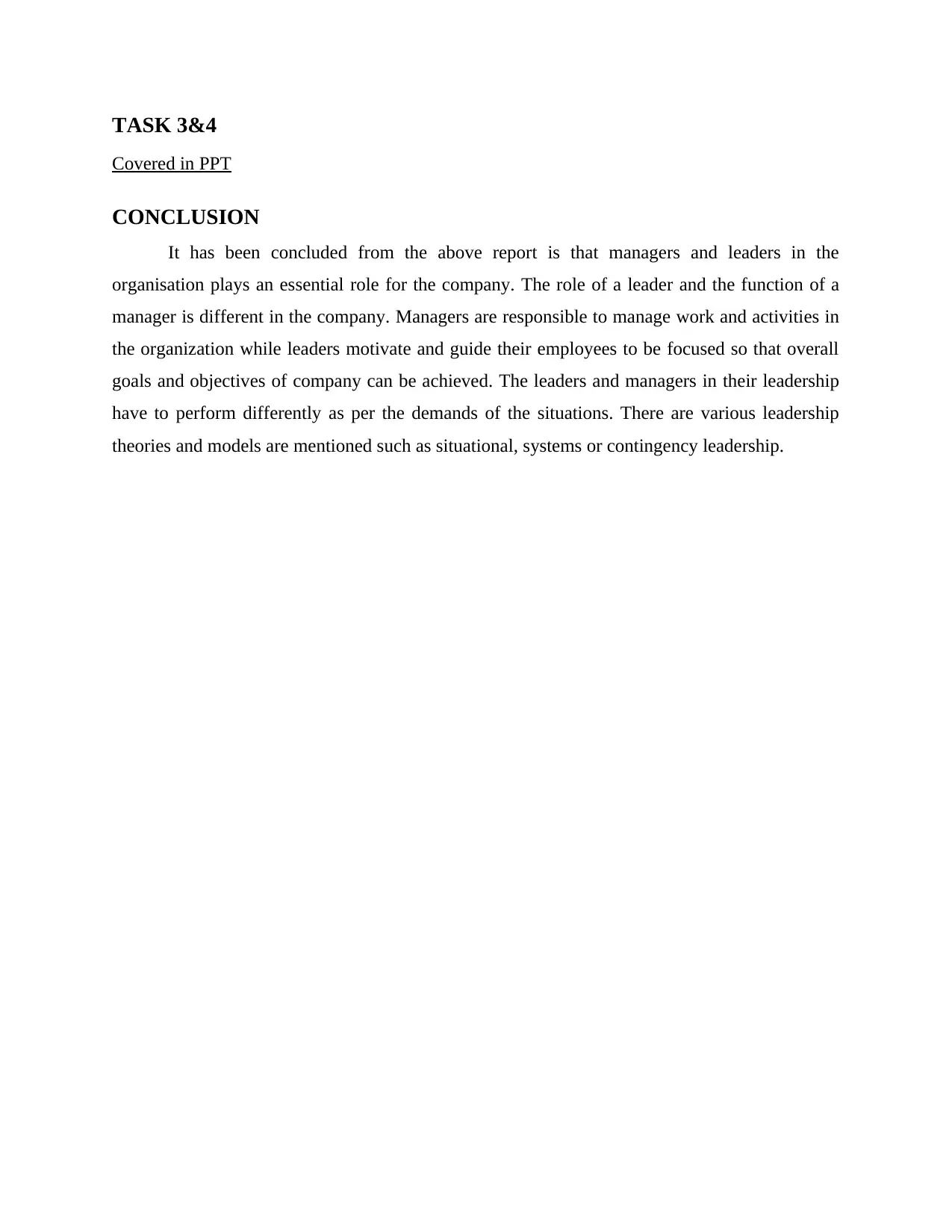
TASK 3&4
Covered in PPT
CONCLUSION
It has been concluded from the above report is that managers and leaders in the
organisation plays an essential role for the company. The role of a leader and the function of a
manager is different in the company. Managers are responsible to manage work and activities in
the organization while leaders motivate and guide their employees to be focused so that overall
goals and objectives of company can be achieved. The leaders and managers in their leadership
have to perform differently as per the demands of the situations. There are various leadership
theories and models are mentioned such as situational, systems or contingency leadership.
Covered in PPT
CONCLUSION
It has been concluded from the above report is that managers and leaders in the
organisation plays an essential role for the company. The role of a leader and the function of a
manager is different in the company. Managers are responsible to manage work and activities in
the organization while leaders motivate and guide their employees to be focused so that overall
goals and objectives of company can be achieved. The leaders and managers in their leadership
have to perform differently as per the demands of the situations. There are various leadership
theories and models are mentioned such as situational, systems or contingency leadership.
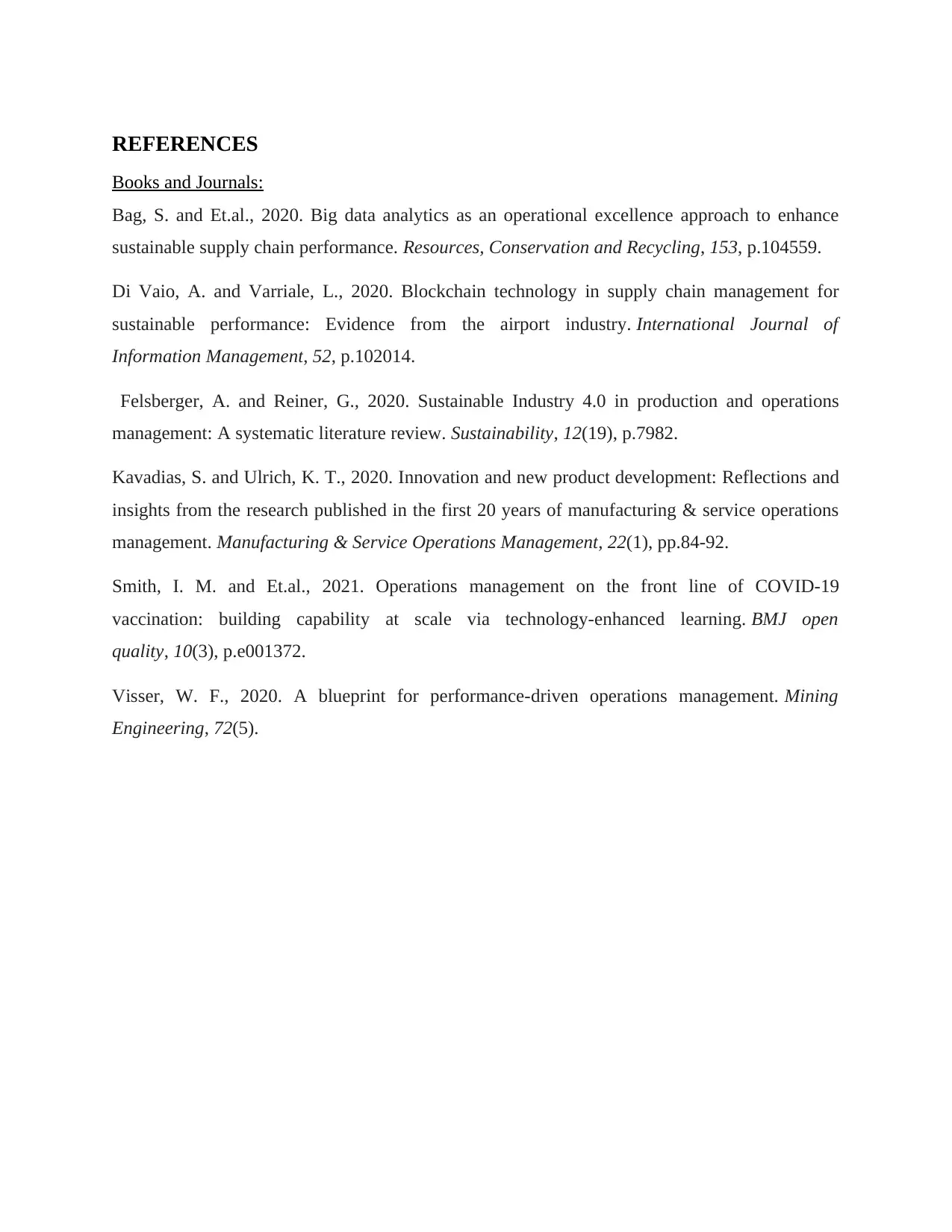
REFERENCES
Books and Journals:
Bag, S. and Et.al., 2020. Big data analytics as an operational excellence approach to enhance
sustainable supply chain performance. Resources, Conservation and Recycling, 153, p.104559.
Di Vaio, A. and Varriale, L., 2020. Blockchain technology in supply chain management for
sustainable performance: Evidence from the airport industry. International Journal of
Information Management, 52, p.102014.
Felsberger, A. and Reiner, G., 2020. Sustainable Industry 4.0 in production and operations
management: A systematic literature review. Sustainability, 12(19), p.7982.
Kavadias, S. and Ulrich, K. T., 2020. Innovation and new product development: Reflections and
insights from the research published in the first 20 years of manufacturing & service operations
management. Manufacturing & Service Operations Management, 22(1), pp.84-92.
Smith, I. M. and Et.al., 2021. Operations management on the front line of COVID-19
vaccination: building capability at scale via technology-enhanced learning. BMJ open
quality, 10(3), p.e001372.
Visser, W. F., 2020. A blueprint for performance-driven operations management. Mining
Engineering, 72(5).
Books and Journals:
Bag, S. and Et.al., 2020. Big data analytics as an operational excellence approach to enhance
sustainable supply chain performance. Resources, Conservation and Recycling, 153, p.104559.
Di Vaio, A. and Varriale, L., 2020. Blockchain technology in supply chain management for
sustainable performance: Evidence from the airport industry. International Journal of
Information Management, 52, p.102014.
Felsberger, A. and Reiner, G., 2020. Sustainable Industry 4.0 in production and operations
management: A systematic literature review. Sustainability, 12(19), p.7982.
Kavadias, S. and Ulrich, K. T., 2020. Innovation and new product development: Reflections and
insights from the research published in the first 20 years of manufacturing & service operations
management. Manufacturing & Service Operations Management, 22(1), pp.84-92.
Smith, I. M. and Et.al., 2021. Operations management on the front line of COVID-19
vaccination: building capability at scale via technology-enhanced learning. BMJ open
quality, 10(3), p.e001372.
Visser, W. F., 2020. A blueprint for performance-driven operations management. Mining
Engineering, 72(5).
⊘ This is a preview!⊘
Do you want full access?
Subscribe today to unlock all pages.

Trusted by 1+ million students worldwide
1 out of 9
Related Documents
Your All-in-One AI-Powered Toolkit for Academic Success.
+13062052269
info@desklib.com
Available 24*7 on WhatsApp / Email
![[object Object]](/_next/static/media/star-bottom.7253800d.svg)
Unlock your academic potential
Copyright © 2020–2025 A2Z Services. All Rights Reserved. Developed and managed by ZUCOL.





